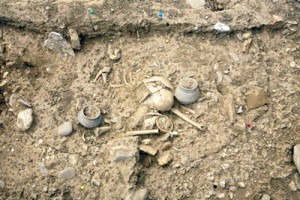Thanks to the find of Irakli Akhvlediani with post to the J2 Fb group and the translation of Robert Sanders we gathered this fascinating information.
Robert: The people found was buried at a Merovingian buriel site in Borgharen in the Dutch province of Limburg, they were wealthy and buried with locals. Artifacts found in the graves are consistent with the Roman-Frankish transitional period. Late Roman to early Middle Ages.
Individual N15 J2a1b-M67 99%. Individual N20 J2b-M102 100% (probably M241). N18 possibly is J2a(a1b1-M92) when comparing to Ysearch database (done by Irakli).
I wonder if N15 (and/or N18) could have any Y-DNA phylogenetically near to BR2 Hungary and HG01302 PuertoRican: tree.j2-m172.info/?Hg=J2a1a1a1b1c1b
Maybe someone is interested and has time to contact the authors if they would be interested in determining/verifying more recent (Late Neolithic/Bronze Age) Y-DNA haplogroups. See the ages of M67 (v3.8 TMRCA 12500 ybp) and subgroups covered at YFull: yfull.com/tree/J2a1b/
Perfect 12/12 matches in J2-M172@FTDNA project to N15 are:
88412 de Neef Lelyveld Netherlands J2-M172
222662 (Cuban from Iberia)? Unknown Origin J2a-CTS2906(xL560)
123370 Semeraro, 1780, Martina Franca, Puglia Italy J2a-M92
Useful to say that M67 kits from other main subclades are 11/12 matches like 230560 Arsanov, Chechen J2a-CTS6804
An additional question interesting to verify would be if the burial site gives indication of any Jewish and/or Levantine connection or not.
Robert: Jewish and/or Levantine connections are not mentioned in the dutch documents. Clues to their origins are the artifacts found in the graves: late Roman early Merovingian pottery, Venus Aphrodite hangers, Avar like horse equipment that seems to be found in Europe along the Danube and Rhine, a lot of weaponry, Roman/Byzantine glass beads comparable to modern day Turkish ones, seashells from the Mediterranean, Red Sea and Indian ocean used for Apotropaeon). The paper also mentions one site at Daalderveld and the one at Paesestraat. The first one seems to be a site for foreigner and the latter one seems to be a site for locals. The J2’s are found in the local area. The paper mentions that these people including individual 15 (J2a1b) come from an area geographically similar to Southern Limburg and that ultimately their family-line may go back to outside Europe. But at the time they were considered locals. They also mention that these people were from areas in the Netherlands know as “dekzand gebieden”. This is interesting since my family-line traces back to such a region called in roman times Sablones which means Sand in Latin. They also found non local horse remains who were given a warriors grave/ending with a sword stab through the hearth. The earliest found artifacts from the site are from 3400 B.C to 2500 B.C, on top of that a Roman Villa was build, in the rubble-field of the Roman Villa the grave field was created (4th-6th cent. A.D). There is evidence that the site was continually inhabited from the Roman Villa era to the grave field construction. After the Merovingian period in the Karolingian period they stopped using the site.
The researchers state that the positioning of the burial field right on the main building of the Roman complex is meaningful, for instance to make a claim of ownership on the land considered to be from their ancestors through a claim of ancestry of the previous inhabitants (in this case Romans).
Why are the authors so certain that the buried men were descendants of the Roman era people? Could they not also be invaders that claimed the area as well as all the items and wealth of previous inhabitants? This question arises because of the Avar items.
Robert: When they talk about Avar like equipment its just that: Avar like, not directly Avar but like it. What comes to mind to me is Sarmatian and/or Thracian horsemen for instance in Roman service. The paper does show the dispersal of these type of equipment along the Rhine Danube frontier. It is known that in the Maastricht area Roman cavalry was stationed. There is no Dutch history telling us of any Avar invasions and in this research which is done with great precision there isn’t a single clue regarding any forceful occupation of any faction or battle or anything to suggest an Avar invasion. Frankish Avar wars occur much later in the Karolingian era. In the Netherlands there are sites that show massive damage that occurred from Germanic assaults on Roman villas and/or castras. Stuff like that is not the case here. They buried among locals, their wifes are locals, their children are locals. The graves were also repeatedly in use so other generations were added to it. Everything is consistent with late Roman early Middle Ages transitional period. Locals wouldn’t have their attackers among them in their graves, this isn’t logical. The reason the researchers put forth this theory instead of an Avar invasion/occupation/replacement is simply because no Avar ‘invasion’ evidence exists. This research covered basically everything there is to research about the grave-site, some type of occupation/replacement would certainly have showed up. What is documented in Dutch history however is the presence of Roman horsemen/legionnaires/farmers from many different J2 rich areas. To me this papers makes a lot of sense as it jives with pretty much everything I’ve been saying for a while now. From the J2b2 indirect descendants of Charlemagne, to the Trojan Frankish origin myth, the descriptions of Tacitus of Asciburgium, Romans Christianity, Equitates, etc. The authors are political/smart enough to not make a definite claim regarding their origins but like I said they do say that the positioning of the burial field right on the main building of the Roman complex is meaningful. It sure does sound logical to me.
Regarding ethnic connections: There is this well known pre-Merovingian figure from the same area: Saint Servatius. He was born in Armenia and died prob. 384 AD in Maastricht.
Translations of some fragments of this paper by Robert:
“The grave-field located at the Pasestraat Borgharen is situated on the location of the main building of a Roman villa. The choice of this location can be considered meaningful, for example as part of a strategy to put claims on the land through a claim on the living-space of the previous inhabitants. who could be considered as ancestors.”
“There is a clear distinction between the 2 different grave-fields: the individuals from Daalderveld are all of non local origin. At the gravesite of the Pasestraat (were they find the J2 results) only 4 individuals are of non local origin, but possibly come from the same geological/geographical area. The last isn’t the case at Daalderveld: here the individuals hail from different geological areas, were some ratios until today are not found within the Netherlands. The results of the origin of the horses also yielded interesting results: one of the animals is also of non local origins and has arrived at Borgharen by trade or migration.”
“The objects who were given with the dead indicate that the grave-field was in use in the 6th and 7th centuries.”
“During the construction of the graves it seems the builders took into account the remaining Roman remains. To which extent this happened and what underlying considerations were responsible for this is not clear.”
“The combination of pottery material and the painted plaster places the use of the villa in the 2nd century.”
“In addition, we attempted to characterize the Y haplogroup for all (possible) male individuals, including the previous study. This was only possible for individuals 15 and 20, for who haplogroup J2 could be granted. With our method J2 can not be further subdivided. For individual 15 haplogroup J2a1 is predicted in the previous investigation on the basis of the Y-STR profile. Meanwhile, it can be refined to J2a1b (99% probability). For individual 20, based on the Y-STR profile haplogroup J2b is predicted (100% probability). In both cases the predicted haplogroups confirm typed haplogroups. Y-haplogroup J2 is carried by 2.7% of Dutch men and is relatively rare in the Netherlands.”
“Particular results have been found with the father and daughter (individuals 15 and 14). Individual 15, the father with a very rare Y chromosome haplotype is of non-local origin (87Sr / 86Sr: 0.7099). He also is probably coming from the Dutch dekzandgebieden. The J haplogroup suggests that the family line originates even beyond western Europe. The 87Sr / 86Sr ratio of his daughter is, however, compatible with the local signal. “
Further informations:
- Maastricht Region Blog: The Merovingian graves of Borgharen
- Leiden University – The ANASTASIS project: The revival of Merovingian studies in the Netherlands
- Merovingers in een villa; Romeinse villa en Merovingisch grafveld Borgharen – Pasestraat. Onderzoek 2008-2009
- Video: Afdekken van een merovingisch grafveld

